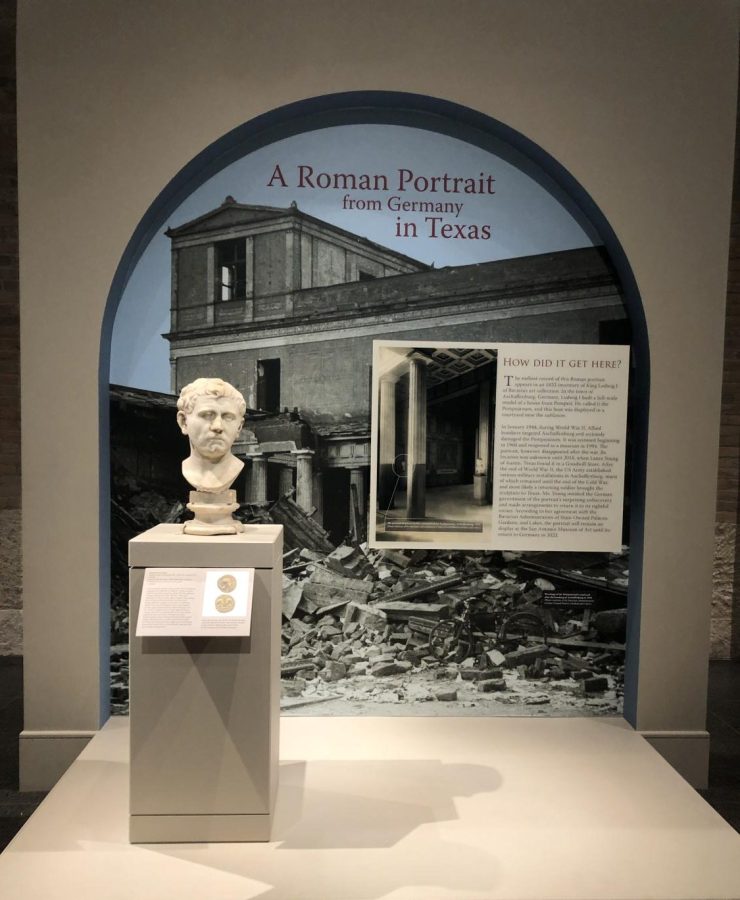The mysterious story of the Roman bust
Ancient Roman sculpture purchased at Austin Goodwill
October 18, 2022
The iconic Roman bust on view at the San Antonio Museum of Art (SAMA) holds a compelling and mysterious story. In the fall of 2018, the bust — a sculpture representation of the upper section of the body — mysteriously ended up at a local Goodwill in Austin, Texas, and was then purchased for $34.99 by Laura Young after it had not been recognized since the end of World War II. A consultant in Europe, who happened to have a photographic memory, remembered seeing the same bust in an old archive and decided to dig deeper into the sculpture’s origin.
Dr. Lynley McAlpine, a postdoctoral curatorial fellow at SAMA, mentions that after the bust was studied further, it was brought to the art department at The University of Texas at Austin (UT), where they held their regular archeologist conference. Here, they brought the bust into a lecture hall which was the first time people could study it together as a group due to COVID-19.
“The first time I saw it was on a table in the lecture hall on campus there,” Dr. McAlpine said. “And everyone agreed that it looks ancient Roman, you know, these are people who’ve looked at a lot of ancient Rome and it definitely looks ancient.”
In Jan. 2019, Jessica Powers, chief curator at SAMA, as well as Dr. McAlpine, were invited to Young’s house to take a final look at the bust because they knew it had to return to Germany at some point.
After conversations about shipping it back to Germany, they were hoping there would be a place to display it in Texas because it has this alluring “Texas story” tied to it.
“I’m just personally lucky that I got to be one of the first people to see it when Laura showed it at UT, and then I also got to see it for over a year in her house,” Dr. McAlpine explains.
There was no place for it at UT’s art museum, so Young got in touch with Curator Powers here at SAMA. After the long process of legal paperwork and verifying details about the bust — such as where in Germany it came from, who it is and how it ended up here — they were able to get it approved to be on view.
As for the details of the sculpture, it took about two years to determine who was depicted in the sculpture, where it came from and how it ended up in Austin.
“I’m not the first person to suggest this, but the identification that I think is the most likely is that it is a man who was called Sextus Pompey,” Dr. McAlpine said.
However, this information is speculative, as the sculpture does not depict an emperor, who would have been more favorable in Roman history. McAlpine continues to explain that rather than Sextus Pompey being an emperor, he was more of an enemy of the state and considered an outlaw. General Pompey the Great — Sextus Pompey’s father — fought in a civil war against General Julius Caesar, before he came into power in Rome. Caesar won the war, as Pompey the Great was essentially murdered. The Pompey sons wanted to continue Pompey the Great’s story and sought justice for their father’s death. Afterward, the Pompey sons, including Sextus, continued to fight against Caesar and his successors, ultimately leading to their deaths.
The bust is on view at SAMA until May of 2023. Afterward, the iconic Roman bust will be shipped back to its home in Germany. Although there is limited time remaining with the bust, it is valuable that it is on view here to honor the small piece of Texas history tied to it.










Susan • Oct 20, 2022 at 3:28 pm
Awesome article